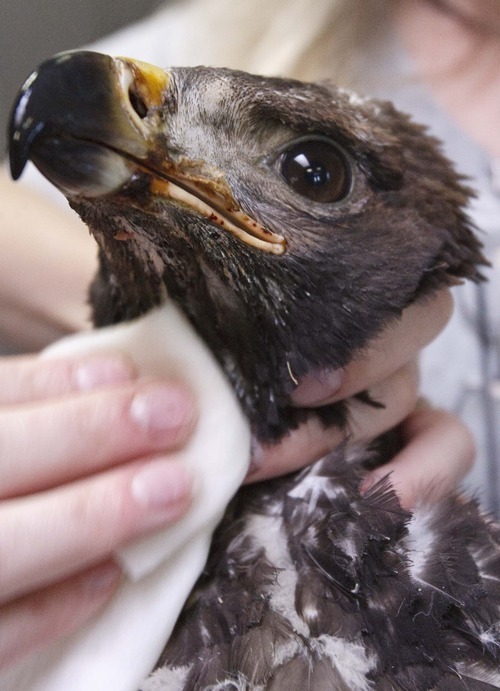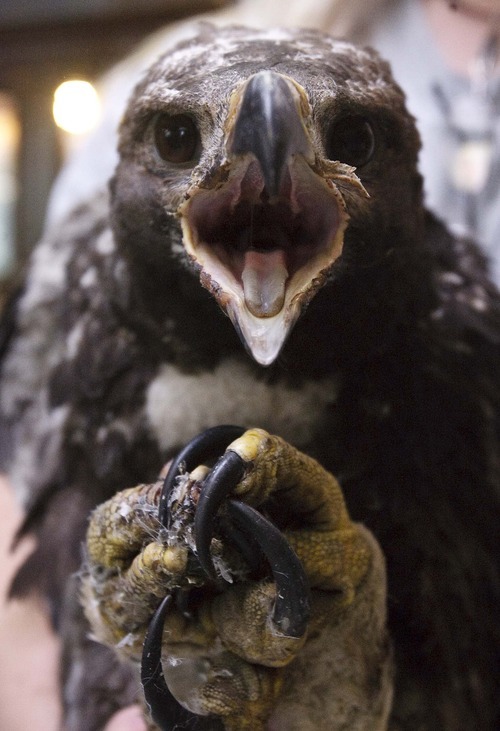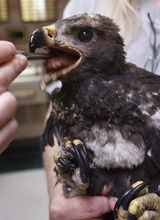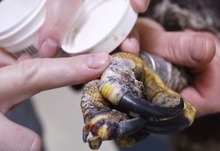This is an archived article that was published on sltrib.com in 2012, and information in the article may be outdated. It is provided only for personal research purposes and may not be reprinted.
The eagle lives.
That alone amazes Kent Keller, who feared the worst upon returning to a flame-scarred nest west of Utah Lake to retrieve the leg band he had attached earlier this year on an eaglet.
The Dump Fire had devastated the area in late June. When Keller looked for the nest through a scope, all he could see was a black mark.
Keller, who has been banding golden eagles as a volunteer and providing reports to the Utah Division of Wildlife Resources for 34 years, climbed through the scorched landscape to document the loss of the nest and the eaglet.
"There was not a stick from the nest left — not on the ground or the cliff," Keller said of his June 28 excursion. "I've seen nests burn before, but this is the first year I have seen one burn with young in it. They are usually long gone and flying when fire season starts."
While standing there, taking in the devastation, Keller noticed a set of eagle legs behind a burned tree at the base of the cliff.
"I thought there was no chance he would be alive. I was stunned when I saw him standing there," said Keller, who has banded more than 1,900 golden eagle chicks in Utah. "I thought maybe I could rebuild the nest a little bit, but I took a good look at him and realized that was not going to happen."
The 70-day-old eaglet had suffered burns on his talons, beak, head and wings — but no injuries to his eyes.
His parents had done what they could for their youngster, dropping food in the form of a cottontail rabbit and a squirrel. Keller realized the eagle would not fly for at least a year and that the parents eventually would stop providing nourishment.
He wanted to take the wounded bird with him then, but knew he had to get permission from federal and state wildlife agencies.
That permission eventually came, and Keller returned on Independence Day to look for the eaglet. He found the raptor in the same spot, where the bird had eaten some food provided by his parents.
The eaglet was delivered to the Wildlife Rehabilitation Center of Northern Utah in Ogden, where he was fittingly dubbed "Phoenix."
DaLyn Erickson, executive director of the center, wondered whether naming the eagle was a wise move.
"I wasn't sure he was going to make it," Erickson recalled. "He kind of had that look like he may have given up."
The eagle was hydrated with a tube down his throat and has since taken to eating beef heart and venison. He is treated several times a day for his burns and seems to be gaining strength.
"He looks good now," said Amber Hansen, a member of the center's board of directors and volunteer. "But we think if he had been there [at the nest site] another day, he probably would not have survived."
But even as Phoenix rises, the question remains: Will he be able to fly?
It's too early to tell, Hansen said. He was just a week or two away from his first attempts, but the volunteers will work to keep him as wild as possible and hope to set him free next spring.
"It depends on how much follicle damage there is to his wings," she said. "If they are not too burned, he should be able to molt into new feathers next year and hopefully be able to fly."
For now, Phoenix spends his days with a cadre of other creatures at the center — about 400, including a beaver, sandhill crane, hummingbirds and yellow-bellied marmots.
Erickson and Patti Richards of Great Basin Wildlife Rescue and Rehabilitation in Utah County say they have not seen an influx of animals from the fires.
"We did get one peregrine falcon that was really emaciated and dehydrated and we are assuming he came from a fire area," Richards said, "but it hasn't been any busier than usual, which is busy."
For Keller, knowing the eaglet is in caring hands and recovering is a good feeling, especially after the horrors the young bird faced.
"I'm sure the smoke was choking him and, once the nest caught fire, he just jumped out and fell 25 feet to the ground," he said. "If he had been a little older, he could have glided to safety. It was a great feeling to find him alive and even better to know he is getting better."

















